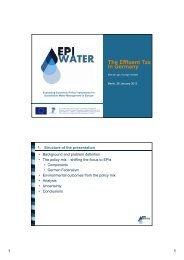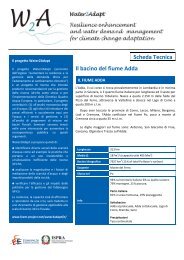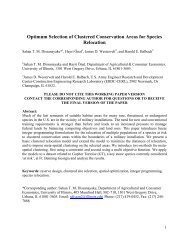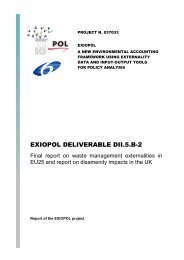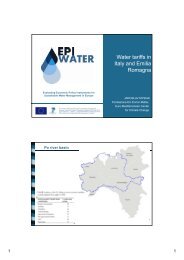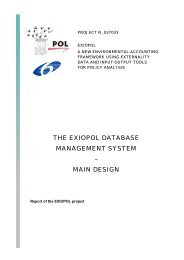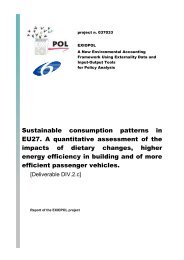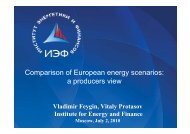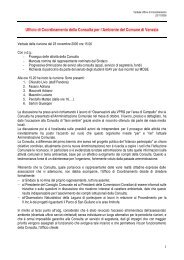Gulf and European Energy Supply Security - Feem-project.net
Gulf and European Energy Supply Security - Feem-project.net
Gulf and European Energy Supply Security - Feem-project.net
You also want an ePaper? Increase the reach of your titles
YUMPU automatically turns print PDFs into web optimized ePapers that Google loves.
•<br />
technologies, overall technical limitations as e.g.<br />
the available l<strong>and</strong> area to install wind turbines<br />
as well as the availability of raw materials) are<br />
considered the technical potential can be derived.<br />
For most resources the technical potential must<br />
be considered in a dynamic context – e.g. with<br />
increased R&D, conversion technologies might<br />
be improved <strong>and</strong>, hence, the technical potential<br />
would increase;<br />
Realizable potential: The realizable potential<br />
represents the achievable potential assuming<br />
that all existing barriers can be overcome <strong>and</strong> all<br />
driving forces are active. The realizable potential<br />
is limited by assumed maximum market growth<br />
rates <strong>and</strong> planning constraints. Therefore, the<br />
realizable potential has to refer to a certain year<br />
– it becomes substantially higher the further one<br />
looks into the future.<br />
1.2 The Economic Dimension of Renewable<br />
<strong>Energy</strong> Technologies<br />
The economic dimension is an important aspect<br />
that will determine the future growth rates of RES<br />
technologies. On the one h<strong>and</strong>, up-front investment<br />
costs are of relevance for potential investors, since<br />
these will determine the resulting generation costs<br />
<strong>and</strong> the achievable profit. On the other h<strong>and</strong>, future<br />
cost reductions will change the overall specific<br />
investment expenditures.<br />
1.2.1 Current economic Characteristics of<br />
Renewable energy Conversion technologies<br />
The broad range of costs for several RES<br />
technology options is caused by site specific<br />
conditions, for example, Photovoltaics or wind<br />
energy locations. Then, costs strongly depend on<br />
the available technological options – compare, for<br />
example, co-firing <strong>and</strong> small-scale CHP plants for<br />
biomass. Dem<strong>and</strong>-specific conditions leading to<br />
various degrees of utilization (e.g. full load hours<br />
in case of heating systems) also affect economics<br />
of RES technologies. All factors together lead to a<br />
broad range of conversion costs.<br />
Nevertheless, in order to give a better<br />
illustration of the current economic conditions of<br />
Overview of RES Characteristics <strong>and</strong> Future Scenarios<br />
the various RES options in the electricity sector<br />
some examples are pointed out here. According<br />
to the above mentioned impact parameters, wind<br />
onshore generation costs vary between 60 €2006/<br />
MWh <strong>and</strong> 105 €2006/MWh whereas offshore wind<br />
generation cost reach up to 150 €2006/MWh. The<br />
biggest range of generation costs is noted in<br />
the Biomass sector from 50 €2006/MWh to 210<br />
€2006/MWh. At the end of the scale solar energy<br />
converters, especially Photovoltaics amount to<br />
380 €2006/MWh up to 1200 €/MWh.<br />
In contrast, the heat sector distinguishes<br />
between grid connected heat supply <strong>and</strong> nongrid<br />
connected heat supply, wherein the latter<br />
faces higher market prices. Among the RES-H<br />
technologies, solid biomass is in most cases<br />
within the non-grid connected sector, already<br />
competitive with conventional options (50 €2006/<br />
MWh to 75 €2006/MWh). Again solar thermal<br />
power generation is on the upper end at 75€ 2006/<br />
MWh up to 200 €2006/MWh. Grid connected heat<br />
supply systems vary between 30 €2006/MWh <strong>and</strong><br />
120 €2006/MWh.<br />
Finally, in the transport sector the costs of all<br />
technologies are still above the current market price<br />
<strong>and</strong> therefore depend on financial support measures<br />
(bioethanol 60 €2006/MWh to 100 €2006/MWh <strong>and</strong><br />
biodiesel 55 €2006/MWh to 65 €2006/MWh).<br />
1.2.2 Future Development of economics of<br />
Renewable energy Conversion technologies<br />
With respect to the future cost development,<br />
technological learning is a crucial parameter,<br />
especially in the mid- to long term. Technological<br />
learning considers a certain cost reduction with<br />
each doubling of produced output. As learning<br />
takes place on the international level, the<br />
deployment of a technology on the global level<br />
must be considered. In order to illustrate the<br />
development of initial investment costs, influenced<br />
by learning effects but also by other parameters<br />
such as raw material prices <strong>and</strong> oil prices, Figure 1<br />
depicts the cost development exemplarily for the<br />
electricity generation technologies up to the year<br />
2030. Remarkable is the negative development<br />
in the period 2007 to 2009 for most energy




